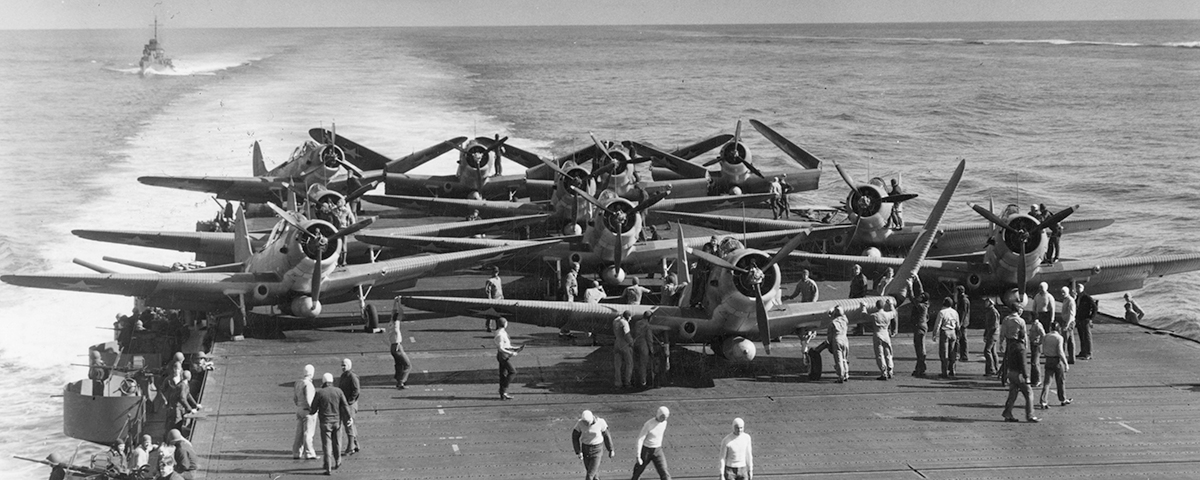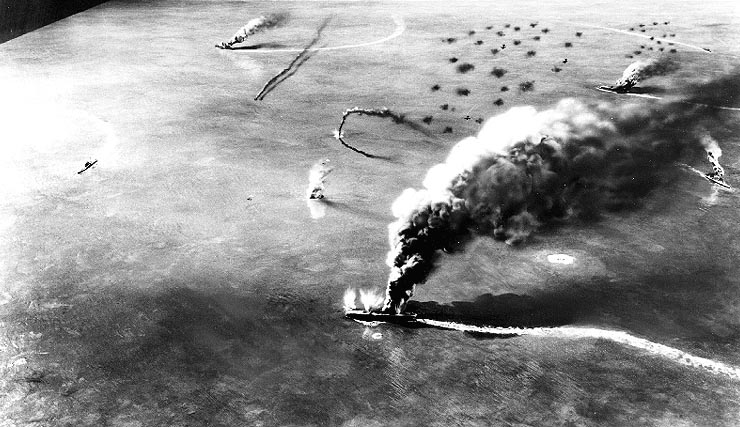.jpg?width=960&height=640&name=unnamed%20(18).jpg)
Throughout his life, Clarence Wade McClusky Junior (known as Wade McClusky) insisted that he was just doing what he was trained to do. However, the scribes of history have repeatedly praised his intuition for helping Americans win the decisive Battle of Midway, which became a critical turning point for the U.S. and the Allies in World War 2. McClusky is a USNA graduate with a large legacy who has humbly become one of the greatest war heroes in America’s history. Let’s dive into his incredible story.
The Early Years
Wade McClusky Jr’s life started out quietly enough. He was born to C.W. and Marie McClusky in Buffalo, New York, the second of five children. He received an appointment to USNA and graduated in June 1926. Three years later he took to the skies as a naval aviator. McClusky then served several tours of duty, including with various air units and command staff; at one point he served as a USNA instructor and worked at other on-shore facilities. When World War 2 was gathering steam in Europe in 1940, he moved to Fighting Squadron Six (VF-6), which was on USS Enterprise (CV-6); McClusky then took command of the squadron in April 1941.

The Most Meaningful Moment at Midway
On December 7, 1941, the war hit home with the attack on Pearl Harbor in Honolulu, Hawaii. A few short months later in April 1942, Lieutenant Commander McClusky became the Enterprise air group commander, a role that would forever enshrine him in the annals of war history. It was 10:00 AM on June 4, 1942, and he led a group of 32 dive-bombers over the middle of the Pacific Ocean near the Midway Atoll. Their mission was to attack the Kido Butai Fleet, the Imperial Japanese Navy’s Admiral Chūichi Nagumo’s formidable aircraft carriers, which were key players helping them win the war in the Pacific for their country and the Axis alliance. There was just one problem—the Japanese fleet wasn’t positioned where Navy intelligence had reported it to be. Wasting no time, McClusky observed the Japanese destroyer Arashi was heading northeast. He deduced it would be following the main Kido Butai Fleet, so he followed it. This was risky—his squadron’s fuel was running low so traveling off course could be deadly—and by following this trajectory, he was blatantly disobeying orders.
What he did next was crucial. When McClusky realized his coordinates were old and therefore inaccurate, he knew not to speak over the radio to ask for updated instructions. As he learned later, even if he had broken the silence, this request wouldn’t have helped since the Enterprise staff did not know about the fleet location change. Even though the commander of Fighting Squadron Six (McClusky’s previous role), Lieutenant Jim Gray, had radioed his contact report around 10:00 AM after circling the Japanese fleet for almost an hour, his report only noted he was leaving due to low fuel and did not provide updated coordinates.
By 10:00 AM, McClusky and his squadron had almost reached the fleet of their own accord. Even without clear intelligence, McClusky continued on. He traveled southwest for another fifteen minutes past the original proposed interception point, thinking there was a good possibility the Japanese fleet was further west than he had initially surmised.
Then came his fateful move, known as one of the most critical decisions by any American military leader in the entirety of World War 2. Although McClusky could not see the Japanese carriers of Kido Butai, he felt their presence. Logically, one would assume the fleet was actually past him and were located south of him. However, he somehow knew this was not true. Instead, he intuited the American air attacks and torpedo planes had stymied their progress and that a Japanese cruiser floatplane’s sighting of one of the American task forces had forced Nagumo to take another route, first trying to escape the bombs and torpedoes by heading southeast and then (at 9:17 AM), turning northeast to engage with American surface ships for an opportunity to counterattack. McClusky was not aware of any of this information, yet he knew intuitively the Japanese had fallen behind and were still north of his location.
The Rest (As They Say) is History
McClusky, a talented naval fighter pilot, and combat leader, and his fleet decimated the Japanese fleet, bombing the Kaga and Akagi aircraft carriers which were abandoned after the attack. Torpedo-bombers and dive-bombers from the USS Enterprise and the USS Hornet were met by the USS Yorktown squadron that then finished off a third Japanese carrier named the Soryu. The Imperial Japanese naval fleet suffered a devastating blow, losing three of its prized carriers in minutes and ultimately precipitating its downfall a few years later. Yet McClusky always maintained there was no guesswork in that fateful decision; he simply relied on his ample training. To his son, Phil McClusky, the elder said he would have heard about their location if the carriers had passed the interception point and been to the south off to his left since Catalina patrol flying boats (PBY) from Midway would have reported them. When this did not happen, his training led him to surmise that they had not yet arrived.

For six months there had been terrible fighting at Midway, and in a few short minutes, the momentum drained from the Japanese, starting a long decline that culminated with their surrender in 1945. The significance of the Battle of Midway in WW2—and that decisive moment—is that it turned the tide of the war.
After the War
McClusky’s service to his beloved country didn’t stop there. He commanded the escort carrier USS Corregidor (CVE-58) later in the war. He also went on to a number of staff and shore positions following the war. Then in the Korean War, he served as chief of staff to the commanders of the First and Seventh Fleets. From 1952 to 1953 McClusky commanded Naval Air Station in Glenview, Illinois; then from 1954 to 1956, he commanded the Boston Group of the Atlantic Reserve Fleet. Finally, in July 1956, he retired from active duty and was administratively advanced to flag rank to recognize his important contributions to the outcome of World War II. Rear Admiral McClusky passed away on June 27, 1976. Among his many accolades, the USS McClusky (FFG-41) bears his name and legacy.
RELATED: USNA Memorial Hall: A Treasure of the Past, Present and Future
Notable Moments
All midshipmen know the story of McClusky, a man whose training and inner knowing saved countless American lives in one of the biggest conflicts in our nation’s history. Not only did he make a smart split-second decision, but his humility since that act is a shining example of what it means to be a USNA graduate. We are grateful for his service that day and throughout his military career.
We also encourage you to visit the Yard and spend time in Memorial Hall, which honors the sacrifices of our fallen graduates and tells their extraordinary stories. Right outside this sacred space near the entrance to Bancroft Hall is the Monument to the Battle of Midway, a granite tablet with the following inscription.
“Dedicated to the preservation of the memory of Midway where one of the most decisive naval battles in military history was fought.
June 4, 1942
The day when the American Spirit reached unparalleled heights and, in so doing, saved democracy for the Western world.”
Come pay a solemn act of gratitude to the many women and men who have made countless sacrifices for our freedom over the course of American history. We welcome you to the Yard, where small acts of history are happening every day. Support the midshipmen who support us since your dining, shopping, and tours will directly benefit the Brigade. Every visit you make makes a difference.



.png)


